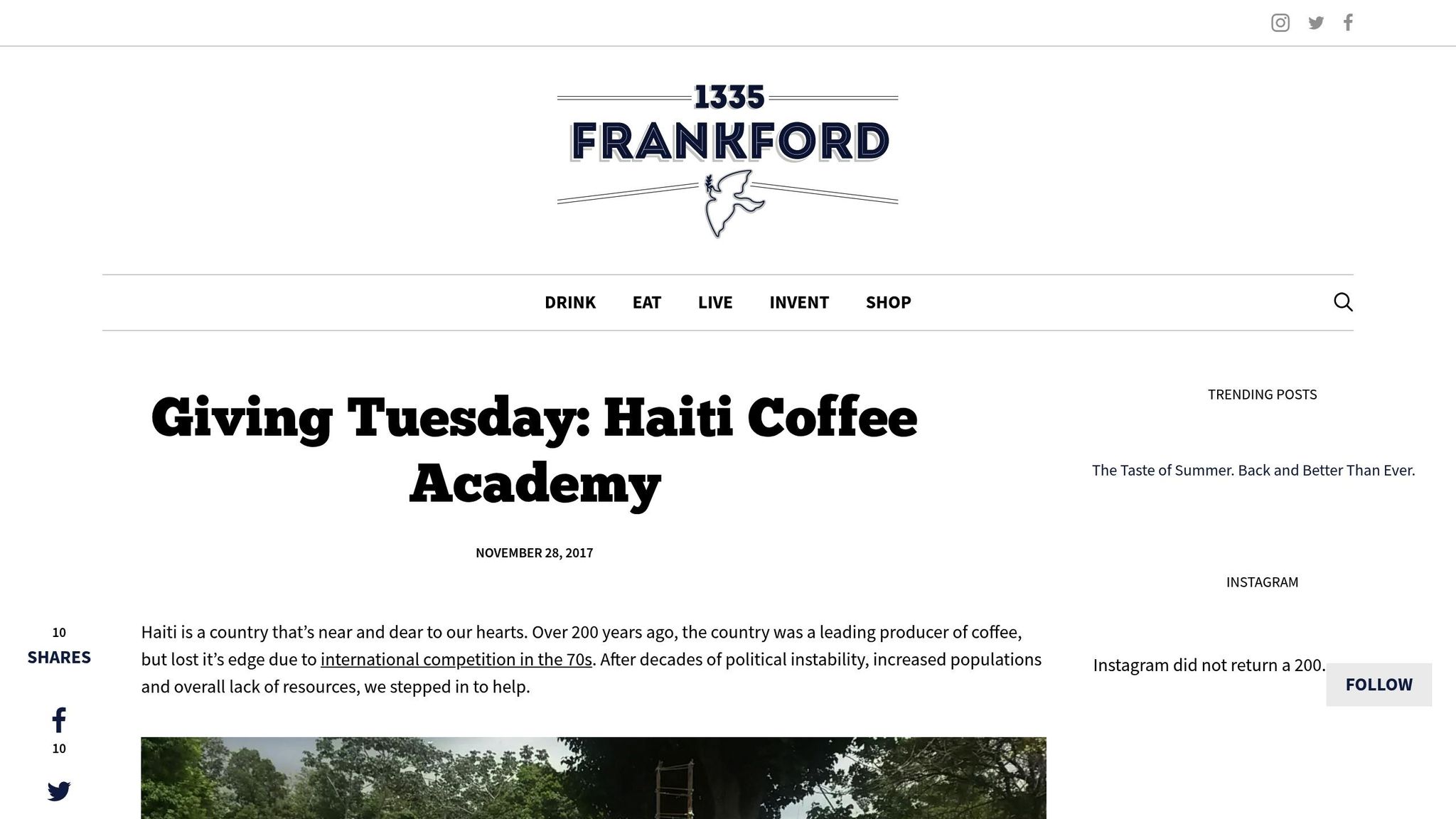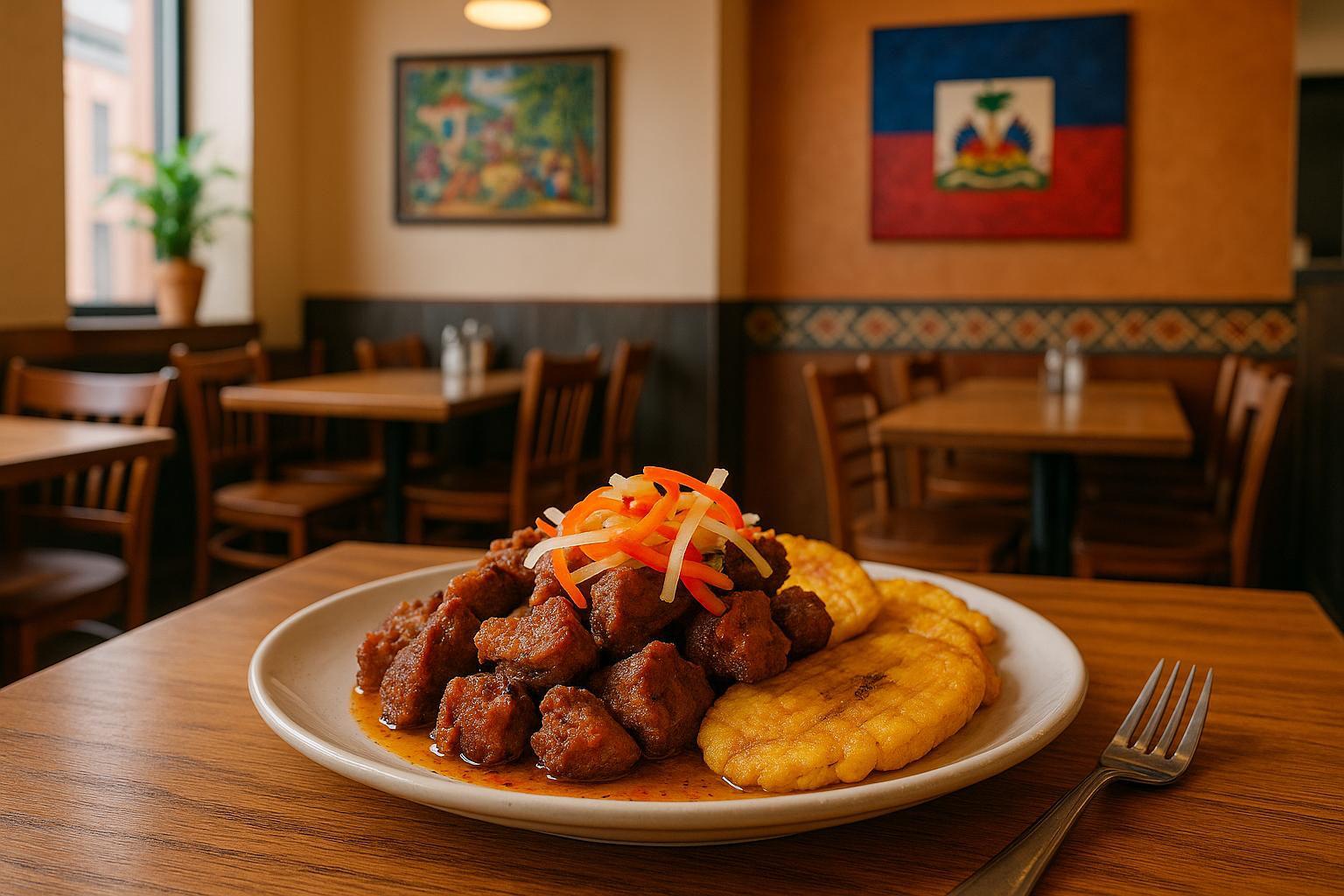Haitian coffee is making a comeback in the global market, thanks to its high-quality beans and eco-friendly farming practices. Once a leading coffee producer in the 18th century, Haiti is now targeting the specialty coffee market, where consumers prioritize ethical sourcing and premium flavors. Here's what you need to know:
- Why it's popular: Haitian coffee is grown using natural methods without synthetic pesticides, aligning with consumer preferences for clean and ethical products.
- Scaling production: Smallholder farmers work through cooperatives to access resources, ensure quality, and connect with international buyers. Investments in infrastructure and training are improving processing and export systems.
- Export process: Quality control is rigorous, with beans graded, processed, and packaged to meet international standards. Certifications like Fair Trade and direct trade models help farmers secure better prices and community benefits.
- Challenges: Climate changes, outdated infrastructure, and logistical issues remain obstacles. However, niche markets for specialty coffee offer growth potential.
Haiti’s coffee industry is leveraging its heritage and modernizing its approach to meet the rising demand for premium coffee worldwide.
The Story of the Haiti Coffee Academy

What Makes Haitian Coffee Popular Worldwide
Haitian coffee has captured global attention, thanks to its commitment to natural and eco-friendly farming practices. Farmers in Haiti rely on traditional methods, steering clear of synthetic pesticides and fertilizers. This approach not only honors age-old techniques but also produces beans that stand out for their quality and authenticity.
In an era where ethical and transparent sourcing matters to consumers, Haitian coffee shines as a symbol of sustainable farming. Its growing reputation in the specialty coffee market reflects this blend of tradition and responsibility.
Scaling Production to Meet International Demand
Expanding Haitian coffee production to meet increasing global demand requires careful planning to maintain its renowned quality. This growth leans heavily on collaboration among smallholder farmers and cooperative networks.
Role of Smallholder Farmers and Cooperatives
Haiti’s coffee industry thrives on the collective strength of smallholder farmers working through cooperatives. These networks, like Kok Ki Chante, play a crucial role by providing farmers with resources such as training, infrastructure improvements, and sustainable farming techniques. They also connect farmers with international buyers, creating opportunities for broader market access [1]. By coordinating efforts - like synchronizing harvest schedules and standardizing processing methods - cooperatives ensure that coffee quality remains consistent, even across numerous small farms.
Infrastructure and Technology Investments
One of the biggest challenges in scaling Haitian coffee production has been outdated infrastructure for processing and transportation. To address this, investments are being made to modernize facilities, enhancing both capacity and quality control [2]. Adopting industrial processing techniques allows producers to have greater oversight of the value chain, ensuring higher standards [2].
Efforts to improve storage, selection, and transportation processes are also underway. For example, F2F volunteer Mathias Medina has provided training on quality management and enterprise strategies, helping farmers meet global market expectations [2]. These advancements are laying the groundwork for a more efficient export system, enabling Haitian coffee to compete on an international scale.
sbb-itb-80c33ff
Navigating the Export Process and Market Access
Haitian coffee's journey from mountain farms to international markets is no small feat. It requires meeting strict quality standards and navigating complex regulations, all while ensuring the coffee aligns with the expectations of global buyers.
Export Workflow and Quality Control
The export process begins at the cooperative level, where coffee cherries are carefully processed and graded. After harvesting, the cherries go through either wet or dry processing methods to bring out their best flavors. From there, they are sorted by size, density, and appearance, using a mix of manual labor and mechanical tools.
Quality control is a top priority at every step. Trained cuppers analyze samples for essential characteristics like aroma, flavor, acidity, and body, following standardized protocols. Only beans that meet these high standards move forward for export.
To ensure compliance with international standards, detailed records are maintained for every shipment. This includes export certificates, phytosanitary reports, and quality assessments, all of which ensure traceability and accountability.
Once ready for export, the coffee is packaged using upgraded materials and stored in climate-controlled conditions to preserve its quality during transit. These measures, supported by improved infrastructure, help Haitian coffee consistently meet the expectations of global markets. And beyond just quality, these practices promote ethical trade, enhancing Haiti’s reputation in the coffee industry.
Fair Trade and Direct Trade Initiatives

Fair Trade certification has been a game-changer for many Haitian coffee cooperatives. It guarantees farmers a minimum price for their coffee, along with additional premiums that support community projects. Beyond fair pricing, these programs emphasize democratic decision-making, fair labor practices, and environmental responsibility.
Direct trade has also gained traction. By cutting out intermediaries, this model allows roasters to work directly with cooperatives. This often leads to better prices for farmers and a more transparent supply chain.
The financial benefits from these initiatives go far beyond individual farmers. Premium pricing from Fair Trade programs supports infrastructure improvements, education, and healthcare in coffee-growing communities. Meanwhile, multi-year contracts from direct trade relationships provide farmers with income stability and the ability to plan for the future.
In many cases, these partnerships extend beyond financial transactions. International buyers often offer technical support, equipment, and training to help cooperatives refine their processes and keep up with changing market demands.
Support from National and International Institutions
Haiti’s coffee exports also benefit from the backing of national agencies and international programs. These organizations focus on improving post-harvest processing, cooperative management, and market access.
Investments in infrastructure, such as better roads and upgraded port facilities, have helped reduce costs and shipping delays. This ensures that coffee shipments arrive in peak condition.
Additionally, cooperatives receive support in meeting certification requirements for organic, Fair Trade, and other specialty standards. This includes help with documentation, inspection preparation, and ongoing compliance.
Market intelligence provided by these programs is another critical resource. By offering insights into global trends and pricing, they help Haitian exporters identify the best markets for their coffee and develop strategies to stand out in a competitive industry.
Overcoming Challenges in Scaling Haitian Coffee Exports
Haitian coffee producers have made strides in improving quality and building partnerships, but significant hurdles remain. Environmental pressures, infrastructure gaps, and logistical obstacles continue to complicate efforts to scale exports. Tackling these issues is crucial for the industry’s growth and resilience.
Climate Change and Weather Risks
Unpredictable weather patterns and shifting climates are reshaping the coffee-growing landscape in Haiti. These changes threaten traditional farming methods, pushing producers to rethink their approaches. To adapt, some cooperatives are turning to agroforestry, a method that combines coffee plants with shade trees. This approach helps regulate temperatures, conserve water, and create a more stable environment for coffee cultivation.
Infrastructure and Logistical Challenges
Weak infrastructure is another major roadblock. Limited port facilities, unreliable electricity, and insufficient storage capacity disrupt the supply chain, making it harder to maintain consistent exports. To address these issues, producers and cooperatives are exploring investments in better logistics systems and alternative energy sources. These improvements could streamline operations and make exporting more reliable. At the same time, producers are looking toward niche markets to increase their profitability.
Opportunities in Niche and Specialty Markets
Amid these challenges, niche and specialty markets offer a pathway for growth. International buyers increasingly value coffee with unique origin stories and distinct flavor profiles. Haitian producers can leverage their heritage and sustainable farming methods to attract these consumers. By focusing on storytelling, building direct connections with roasters and retailers, and participating in industry events, they can carve out a stronger presence in the specialty coffee scene.
Overcoming these obstacles is critical for Haitian coffee to thrive in the competitive global market and secure a brighter future for its producers.
Conclusion: The Future of Haitian Coffee Exports
Haitian coffee stands at an important crossroads, bolstered by determined cooperatives and environmentally conscious farming methods. These efforts have created a strong foundation, enabling Haiti to tap into the increasing global demand for specialty coffee that’s both ethically sourced and high-quality.
To navigate future challenges, particularly those posed by shifting climate conditions, farmers must continue to adopt innovative and flexible agricultural approaches. These strategies will help ensure consistent quality and steady yields. Equally important are ongoing investments in infrastructure, which can streamline export processes and enhance Haiti’s ability to compete in international markets.
Fair compensation and improved access to global markets remain priorities. The success of fair trade initiatives shows that international buyers are willing to pay more when they connect with the story behind the coffee. This not only benefits farmers but also reinforces Haiti’s reputation as a producer of exceptional coffee.
Beyond physical infrastructure, nurturing local talent is key to maintaining this momentum. By investing in skill development and celebrating Haitian coffee’s distinct flavor and cultural significance, the industry can secure a stronger foothold in the global market while honoring its rich heritage.
As the specialty coffee sector continues to grow, Haitian producers are well-positioned to build meaningful, long-term partnerships worldwide. To explore more about Haiti’s vibrant food and beverage traditions, visit HaitianFoods.org.
FAQs
What challenges do Haitian coffee producers face in expanding exports to meet global demand?
Haitian coffee producers face a tough road when it comes to scaling their exports to meet rising global demand. Natural disasters like hurricanes and earthquakes have wreaked havoc on farms and infrastructure, cutting into productivity. On top of that, challenges like shifting climate patterns and coffee plant diseases make growing and harvesting coffee even more difficult.
But it’s not just nature that’s creating roadblocks. Outdated farming techniques, limited access to modern tools, and ongoing land ownership disputes are slowing progress. Add to that poor infrastructure - think crumbling roads and unreliable transportation networks - and an unstable economy, and it’s clear why expanding export capacity is such a challenge. Overcoming these hurdles is key if Haiti wants to establish itself as a major player in the premium coffee market.
How do Fair Trade and direct trade programs support Haitian coffee farmers and their communities?
Fair Trade programs provide Haitian coffee farmers with a safety net by guaranteeing a minimum price for their coffee. This ensures they can maintain a stable income, regardless of market fluctuations. Beyond financial security, these programs emphasize fair labor practices and encourage farming methods that are kinder to the environment. The result? A win for both the farmers and the planet.
Direct trade takes things even further by removing the middlemen. Buyers work directly with farmers, which often means growers receive higher payments. These increased earnings enable farmers to invest in critical needs like food, healthcare, and education. Over time, this approach strengthens local communities and opens up lasting opportunities for Haitian coffee producers and their families.
How is Haiti upgrading its coffee industry to meet growing global demand?
Haiti is taking steps to revitalize its coffee industry, aiming to keep up with growing global demand. Farmers are adopting better agricultural methods to increase production and reduce losses after harvest. At the same time, investments in infrastructure are being made to meet USDA standards, which could lead to an annual export boost of about $14 million.
Producers are also working on diversifying crops to improve yields, enhance quality, and build resilience. These efforts are part of a larger plan to simplify export processes and solidify Haiti’s role in the international coffee market.


